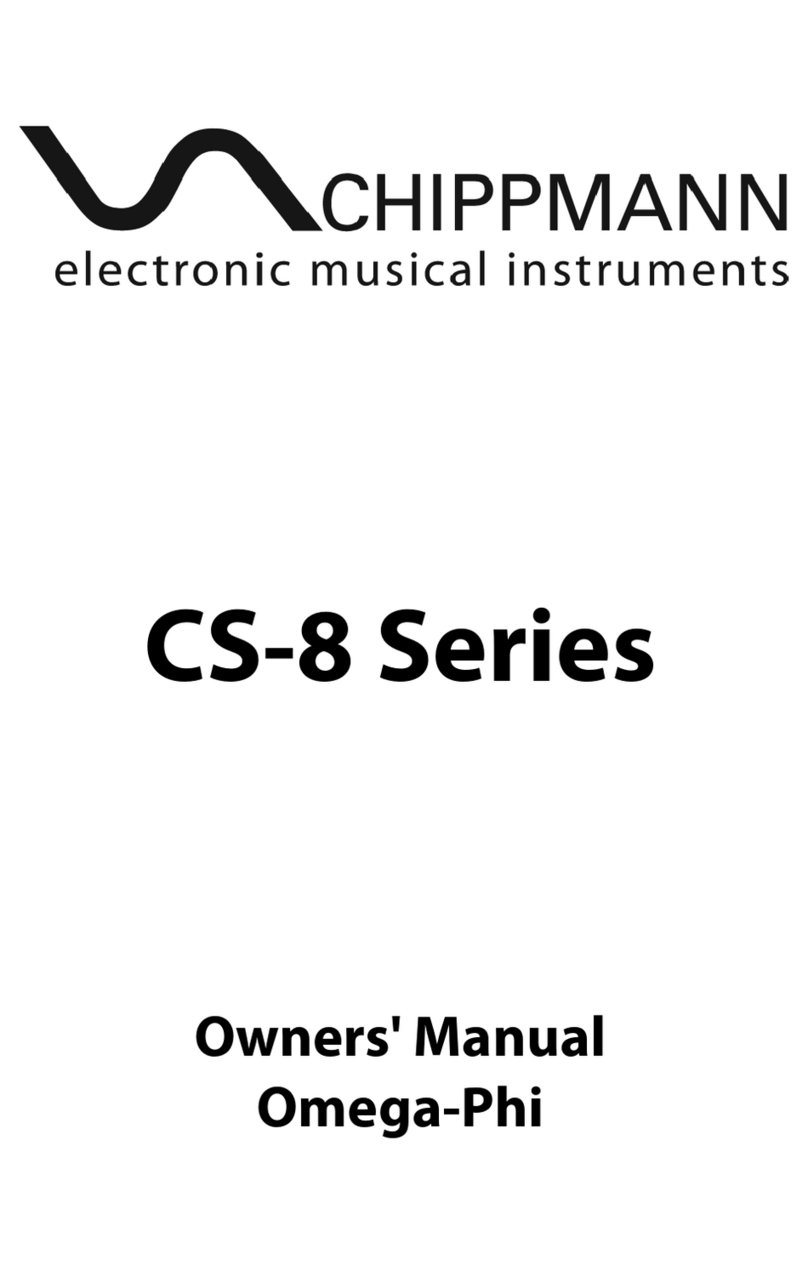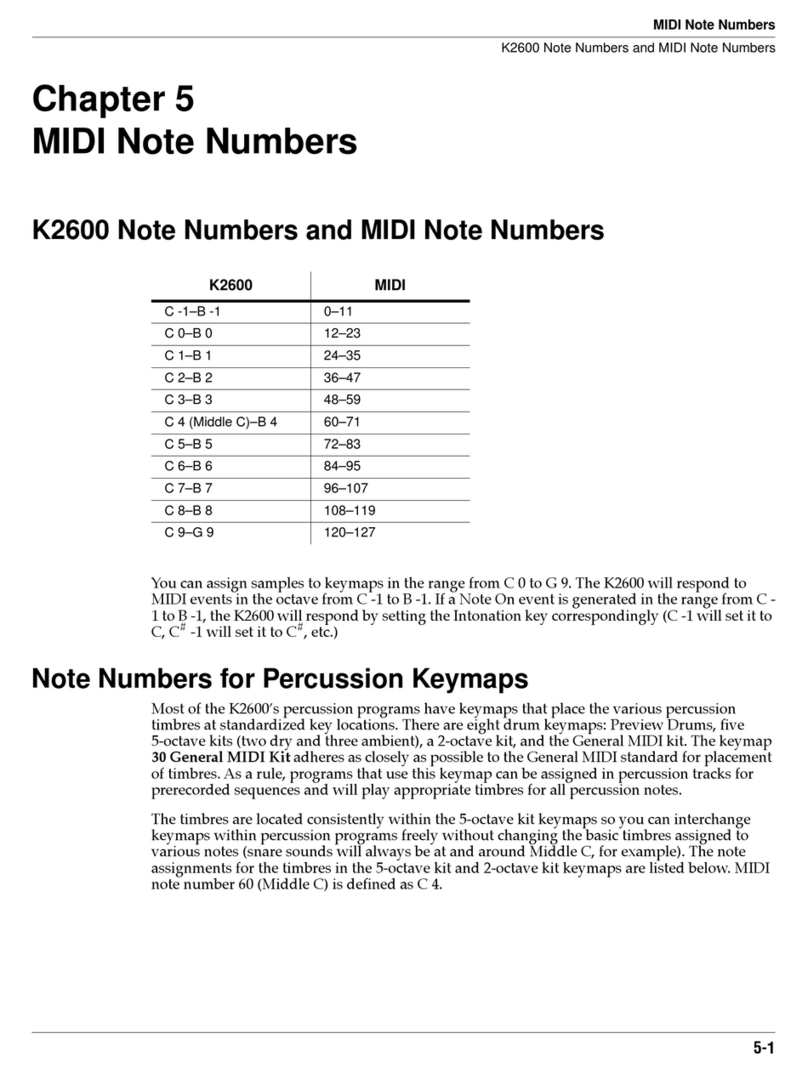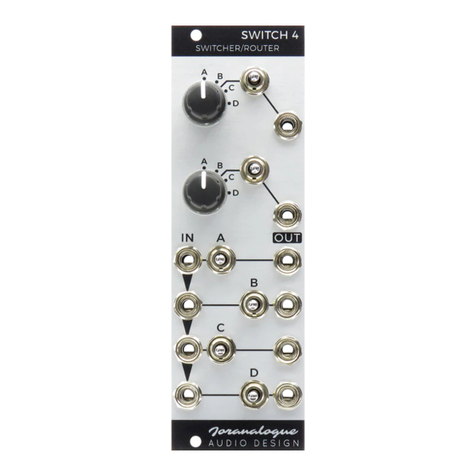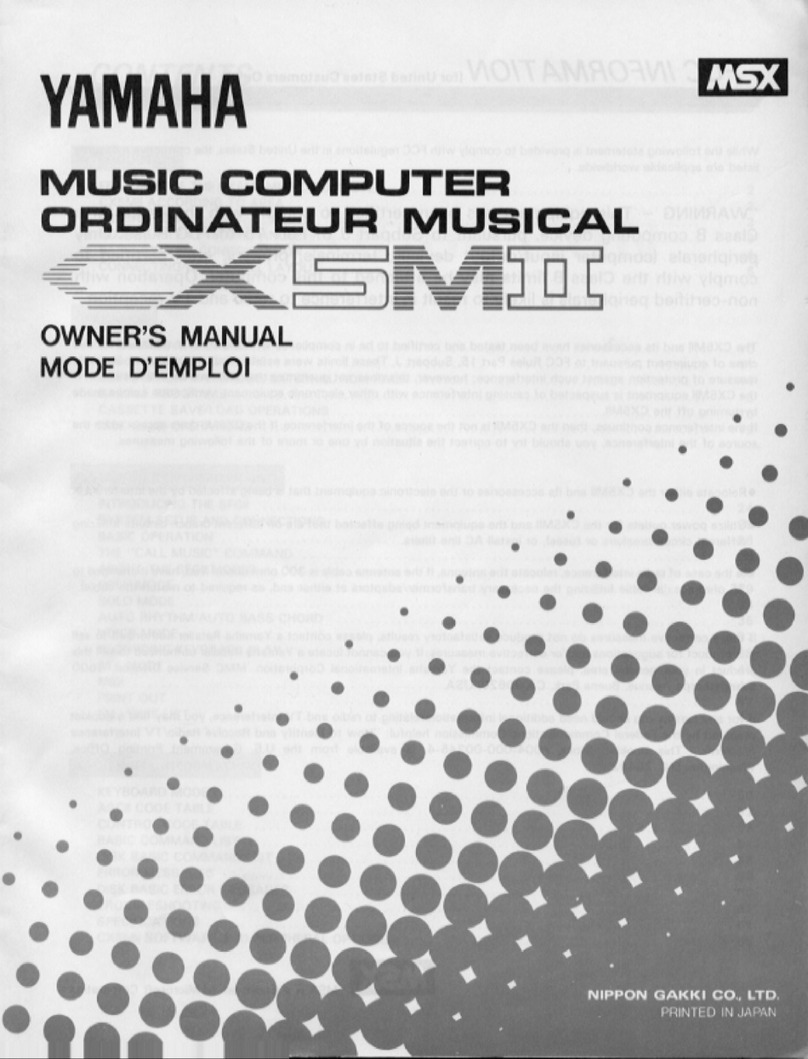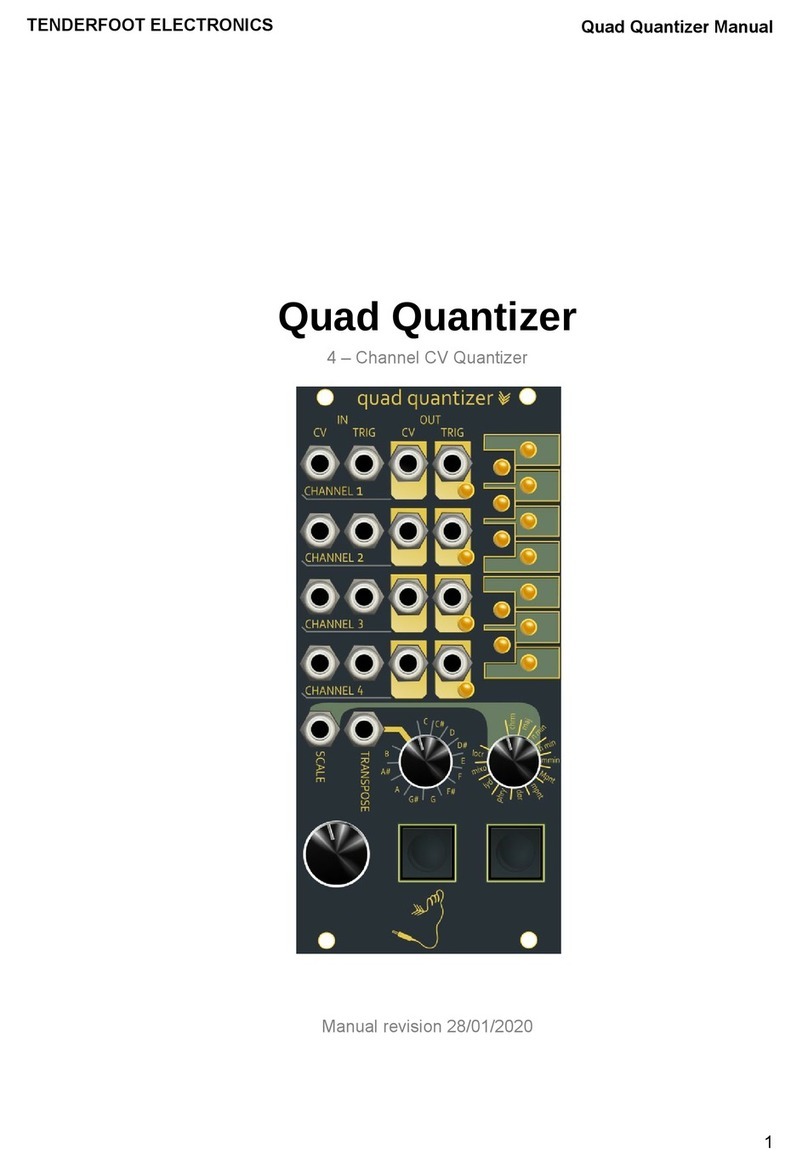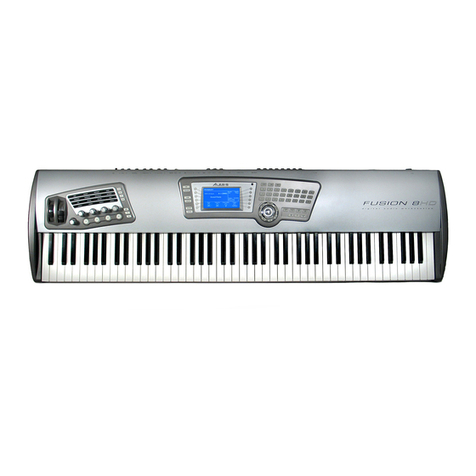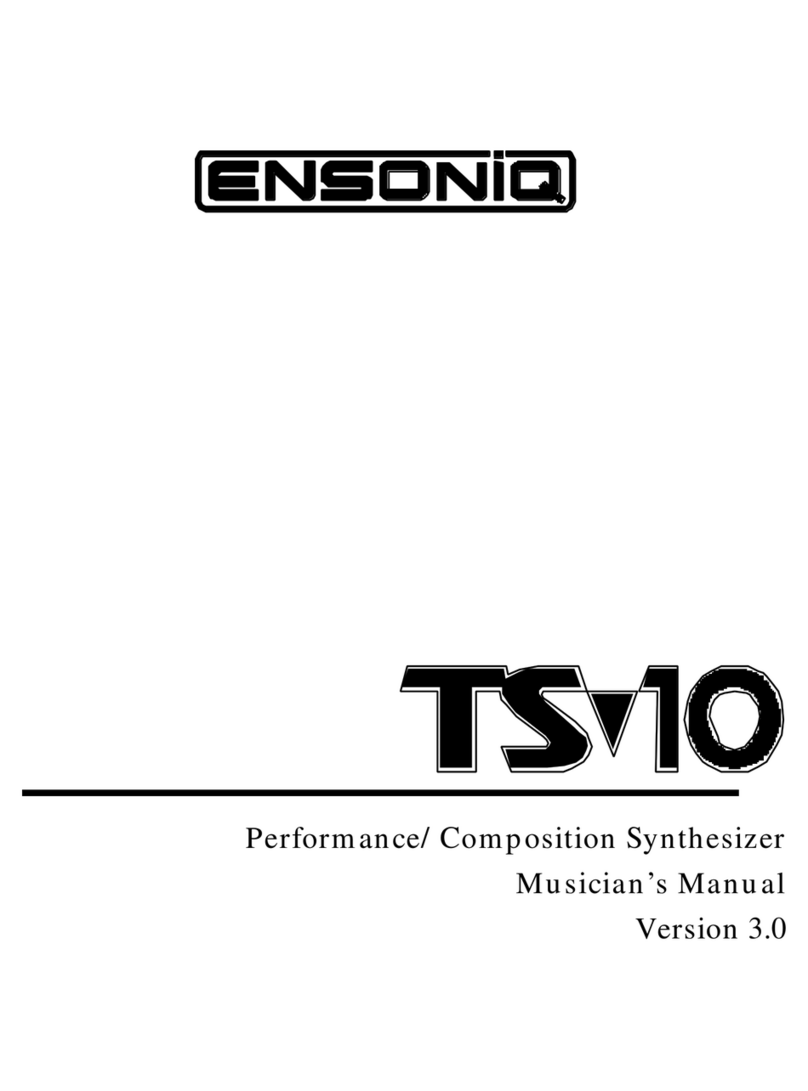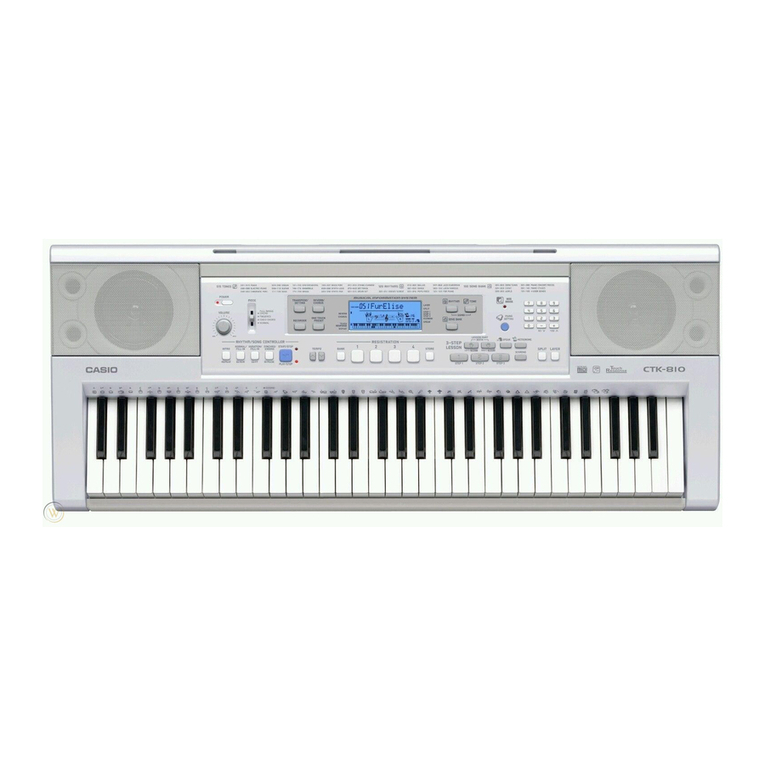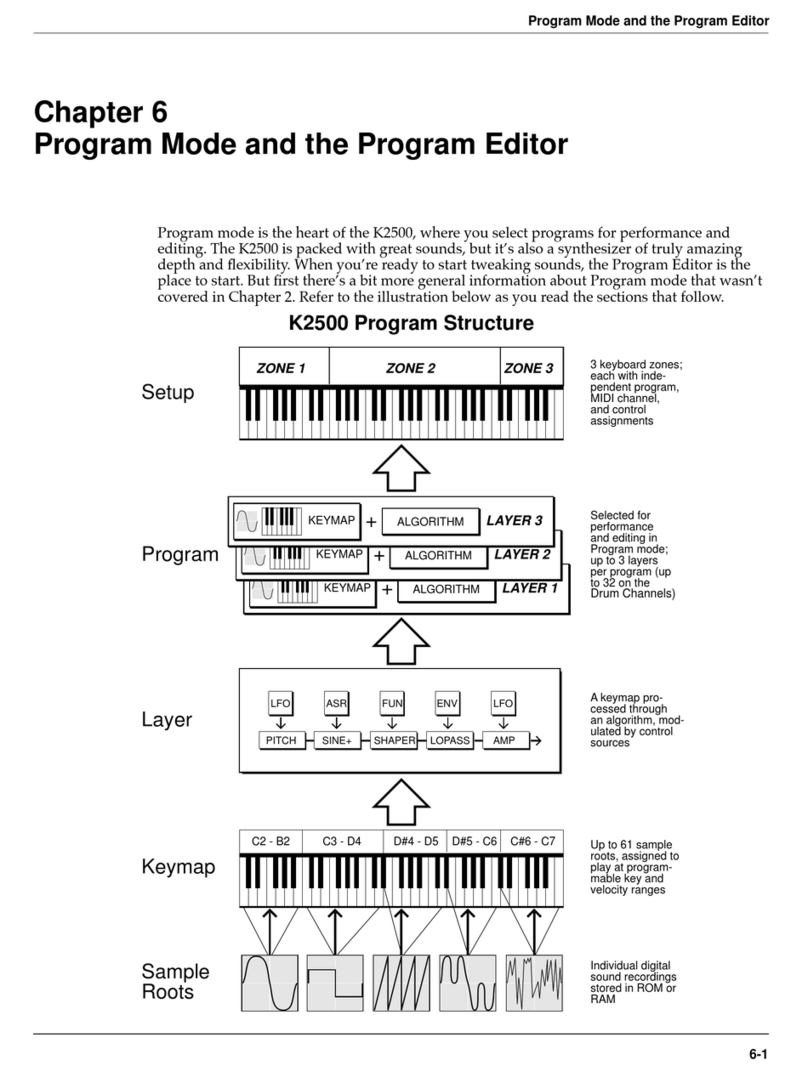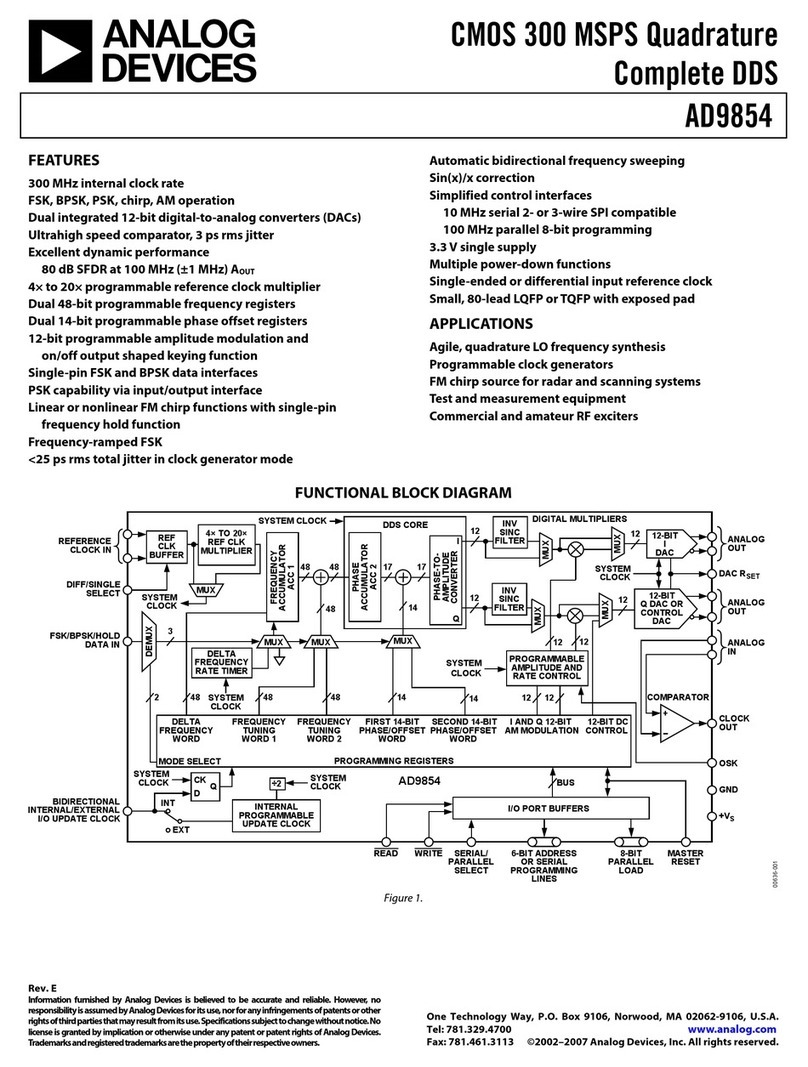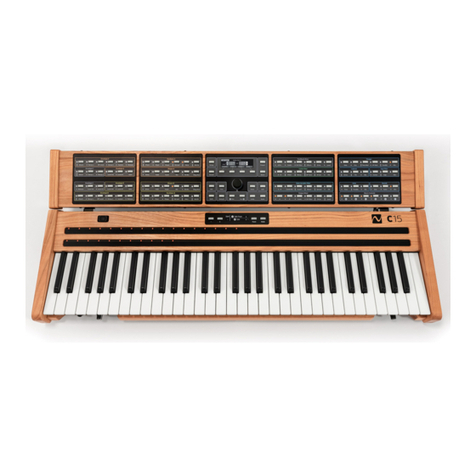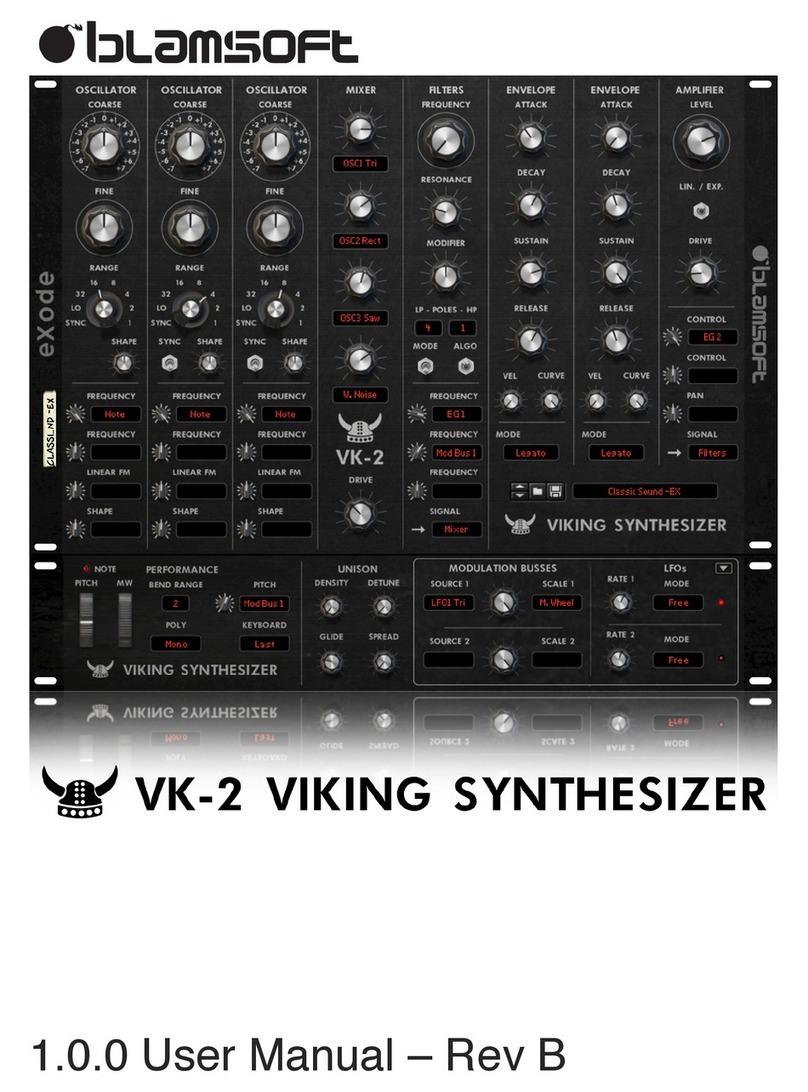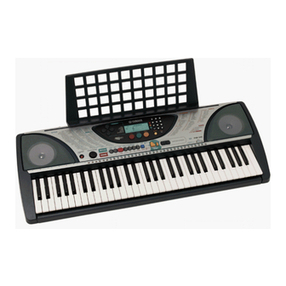Chippmann CS-8 Series User manual

CS-8 Series
Owners' manual DTG


CS-8 Series DTG Rev1.2, May 2020
-1-
User manual by Carsten Schi mann
Gra hic design CS-8 Series: Carsten Schi mann
Conce t and develo ment: Carsten Schi mann
English translation by Carsten Schi mann
Contact:
Schi mann electronic musical instruments
Di l.-Ing. Carsten Schi mann
Wartburgstr. 8
D-10823 Berlin
Web: www.schi mann-music.com
Email: info@schi mann-music.com
The manufacturer
Schi mann electronic musical instruments
is constantly
striving for im rovements and develo ments of their roducts. Therefore, we
reserve the right to change technical s ecifications which im rove our
roducts at any time without notice. This includes the look of the unit which
might differ from ictures in this manual.
No art of this ublication is to be re roduced, transmitted, transcribed or
translated in any form or by any means whatsoever without written
ermission by
Schi mann electronic musical instruments
.
2020, Schi mann electronic musical instruments, errors exce ted, subject
to change without rior notice.

CS-8 Series DTG Rev1.2, May 2020
-2-
PREFACE
First of all, congratulations on the urchase of this 3U Eurorack synthesizer
module. This manual contains a condensed descri tion of the functionality
and addresses users with a certain level of elementary technical knowledge.
The resent DTG of the CS-8 series is a very flexible and recise fully analogue
dual-transientgenerator, with two time bases, each. One of it generates the
analog transient waveform, the other rovides either a Gate signal (0 V - +5 V)
of definite length, inde endently of the in ut gate length or out uts
(externally switchable) the incoming Gate signal by a definite delay time (Gate
Delay).
All times, Gate length/delay, Attack, Decay, Release as well as the Sustain level
are externally oltage controllable. The Transient generator and also the
Gate can be reset to 0 V out ut voltage, se arately, via a jack. A Hold in ut
allows to "freeze" immediately the current voltage out ut state of the transient
out ut until enabling again. A Decay-Acti e out ut becomes "high" active (+5
V) during the Decay hase. Moreover, it is ossible by a jack to set the Sustain
le el between -10 V and +10 V, meaning after achieving the regular final
value of the attack hase (+5V) the transient out ut will further rise to the
higher Sustain level above (>+5 V) asym totically with the Decay time (second
attack hase).
Conclusively, the conce t is well-rounded by a high-end-VCA for
continuously negative/ ositive out ut of the transient waveform from -5 V
(inverse) crossing the exact zero to +10 V final attack value.
Design and im lementation meet highest technical standards. The front anel
is made from owdered and rinted iece of aluminium sheet metal of 2 mm
gauge. The entire design and roduction work was done in Germany.
Made in Germany

CS-8 Series DTG Rev1.2, May 2020
-3-
1. WARRANTY .........................................................................................................................4
1.1 Limited Warranty ....................................................................................................4
1.2 Terms of Warranty ..................................................................................................4
1.3 Warranty transferability ......................................................................................4
1.4 Claim for damages ..................................................................................................5
2. CE AND FCC COMPLIANCE STATEMENTS ...............................................................5
3. DISPOSAL ............................................................................................................................5
4. SAFETY INSTRUCTIONS .................................................................................................6
5. MAINTAINANCE/ CLEANING ........................................................................................7
6. GETTING STARTET............................................................................................................7
6.1 Unpacking ..................................................................................................................7
6.2 Installation .................................................................................................................7
7. CONTROLS ...........................................................................................................................8
7.1 Front panel .................................................................................................................8
7.2 Back ............................................................................................................................ 13
7.3 Initial operation .................................................................................................... 14
8. MODULE DESCRIPTION ............................................................................................... 14
8.1 Structure .................................................................................................................. 14
8.2 The Gate/Delay section ...................................................................................... 15
8.3 The en elope section .......................................................................................... 17
8.4 Reset function ........................................................................................................ 18
8.5 Hold & Decay acti e out .................................................................................... 19
8.6 Combination of Gate section and En elope section ............................. 20
8.7 Output VCA ............................................................................................................. 21
8.8 Wa eform shaping .............................................................................................. 21
9. TECHNICAL DATA AND SIGNAL VALUES ............................................................. 23
9.1 Technical Data (in general) .............................................................................. 23
9.2 Signals and ratings .............................................................................................. 23

CS-8 Series DTG Rev1.2, May 2020
-4-
1. WARRANTY
1.1 Limited Warranty
Schi mann electronic musical instruments
warrants the mechanical and
electronic com onents of this roduct for a eriod of two (2) years from the
original date of urchase, according to the warranty regulations described
below. However, as a gesture of goodwill we give a lifetime warranty on our
roducts. Nevertheless, this will be always a decision in an individual case. If
the roduct exhibits any faults within the s ecified warranty eriod that are
not excluded from this warranty,
Schi mann electronic musical instruments
shall, at its discretion, either re lace or re air the roduct. This warranty exists
in addition to the general terms of business of the manufacturer
Schi mann
electronic musical instruments
.
1.2 Terms of Warranty
Schi mann electronic musical instruments
reserves the right to execute
warranty services only if the roduct comes with a co y of the dealer’s original
invoice. Final discretion of warranty coverage lies solely with
Schi mann
electronic musical instruments
. Any
Schi mann electronic musical
instruments
roduct deemed eligible for re air or re lacement under the
terms of this warranty will be re aired or re laced within 30 days after
receiving the roduct at
Schi mann electronic musical instruments
.
Damages or defects caused by im ro er handling or o ening of the unit by
unauthorized ersonnel (user included) are not covered by this warranty.
Products which do not meet the terms of this warranty will be re aired
exclusively at the buyer´s ex ense and returned C.O.D. with an invoice for
labour, materials, return shi ing, and insurance. Products re aired under
warranty will be returned with shi ing re aid by
Schi mann electronic
musical instruments
. Outside Germany, products will be returned at the
buyer´s expense.
1.3 Warranty transferability
This warranty is extended to the original urchaser and cannot be transferred.
No other erson (retail dealer, etc) shall be entitled to give any warranty
romise on behalf of
Schi mann electronic musical instruments
.

CS-8 Series DTG Rev1.2, May 2020
-5-
1.4 Claim for damages
Schi mann electronic musical instruments
does not acce t claims for
damages of any kind, es ecially consequential loss or damage, direct or
indirect of any kind however caused. Liability is limited to the value of this
roduct. The general terms of business drawn u by
Schi mann electronic
musical instruments
a ly at all times.
Please note: The controls, switches and jacks are rogramming facilities, no
real-time controllers! Tweak them carefully since we cannot be held liable for
“abused” otentiometers and switches.
2. CE AND FCC COMPLIANCE STATEMENTS
This device has been tested and deemed to com ly with the DIN EN 60065
standards.
This device has been tested and deemed to com ly with the requirements,
listed in FCC Regulations, art 15. The device com lies with EN 55103-1 and
EN 55103-2 standards.
Because of the entirely analogue construction, this device does not generate
radio frequencies and will not interfere with radio frequencies generated by
other electronic devices.
3. DISPOSAL
This device has been manufactured to RoHS-standards, in com liance with the
requirements of the Euro ean arliament and council and is thus free of lead,
mercury, and cadmium.
!! Notice: This product is still special waste and is not to be disposed of
through regular household waste !!
For disposal, please contact your local dealer or Schippmann electronic
musical instruments

CS-8 Series DTG Rev1.2, May 2020
-6-
4. SAFETY INSTRUCTIONS
BEFORE USING THIS PRODUCT FOR THE FIRST TIME, PLEASE READ THE
ENTIRE USER MANUAL THOROUGHLY.
•PLEASE AVOID SHARP BENDING OF ANY CORDS AND CABLES.
•CORDS SHOULD NOT BE INSTALLED WITHIN THE REACH OF CHILDREN
OR PETS.
•DO NOT TREAD THE ENCLOSURE OF THE PRODUCT, DO NOT PLACE
HEAVY OBJECTS ON IT.
•BEFORE REMOVING THE PRODUCT FROM THE RACK, PLEASE
DISCONNECT THE POWER PLUG AND ALL OTHER CABLE
CONNECTIONS.
•PLEASE DISCONNECT THE POWER PLUG FROM THE OUTLET IN CASE OF
A THUNDERSTORM.
•NEVER OPEN THE ENCLOSURE OF THE PRODUCT! NEVER TRY TO
MODIFY THE INTERNAL CIRCUITRY! ONLY QUALIFIED SERVICE
PERSONNEL IS ALLOWED TO OPEN THE ENCLOSURE.
•DO NOT PLACE OPEN FIRE ON TOP OF THE PRODUCT (CANDLES, ASH
TRAYS, HOT THAI CURRIES ETC).
•NEVER EXPOSE THE PRODUCT TO WATER, BEER, OR MOISTURE.
•ADULTS ARE TO MAKE SURE THAT CHILDREN FOLLOW ALL SAFETY
INSTRUCTIONS. SAME THING GOES FOR PETS.
•AVOID MECHANICAL STRESS OR IMPACT. DO NOT DROP THE PRODUCT;
EVEN IF THERE IS A CONTROL LABELLED "DROP"!
•DO NOT USE THE PRODUCT WITH TOO MANY OTHER ELECTRONIC
DEVICES RUNNING FROM ONE SINGLE OUTLET, ESPECIALLY IN
CONNECTION WITH EXTENSION CORDS. DO NOT ATTEMPT TO SAVE
MONEY ON CHEAP SOLUTIONS. BUY PROPER HIGH-DUTY POWER
DISTRIBUTORS AND CORDS!
•NEVER USE EXTENSION CORDS WITH LESS MAXIMUM LOAD THAN THE
TOTAL POWER CONSUMPTION OF ALL DEVICES CONNECTED TO A
SINGLE POWER OUTLET COMBINED. OVERLOADING EXTENSION CORDS
CAN CAUSE FIRE.
•AVOID MECHANICAL STRESS ON JACKS AND KNO S / SWITCHES.
•PROTECT YOUR SPEAKERS AND EARS (!) AGAINST EXCESSIVE AUDIO

CS-8 Series DTG Rev1.2, May 2020
-7-
LEVELS.
5. MAINTAINANCE/ CLEANING
•BEFORE CLEANING THE PRODUCT, PLEASE DISCONNECT THE POWER
PLUG FROM THE OUTLET OR DISCONNECT THE MODULE FROM ITS
POWER CONNECTOR BY PULLING THE FLAT RIBBON CABLE.
•USE A DRY OR SLIGHTLY MOIST CLOTH OR COMPRESSED AIR FOR
CLEANING. NEVER USE ANY CLEANER OR THINNER (E.G. PAINT THINNER
OR ACETON). PRINTS AND PAINTWORK WILL IMEDIATELY BE
DESTROYED!! ALSO AVOID ALCOHOL (ISOPROPYLIC), GAS, SPIRITS
(SCOTCH SINGLE MALTS, FOR A START) OR ABRASIVE HOUSEHOLD
CLEANERS!
6. GETTING STARTET
6.1 Unpacking
The box should contain the following items:
- 1 x CS-8 Series VCF1E 3HU rack-mount module
- 1 x Ribbon cable (20 cm length with two 16 ole IDC-connectors)
- 4 x M3 screws
- 4 x oly ro ylene washers
- this owners’ manual
If the content of the box turns out to be incom lete, lease get in touch with
your dealer or
Schi mann electronic musical instruments
immediately. In
case of damage caused in transit, lease get back to the res onsible carrier
and
Schi mann electronic musical instruments
immediately. We will su ort
you in this case.
6.2 Installation
Place the unit on a clean, dry and sturdy surface, or use a suitable keyboard
stand or 19” rack. For 19” rack mounting, a suitable rack (3U Eurorack with +/-
12V ower su ly rails) is required. The CS-8 DTG uses discrete all-analogue
electronics. Thus certain arameters may be tem erature-sensitive. We

CS-8 Series DTG Rev1.2, May 2020
-8-
recommend lacing the DTG away from heat sources such as radiators, lam s
or other units that roduce heat (e.g. ower am s or internal ower su lies).
7. CONTROLS
7.1 Front panel
Fig. 1 shows the front anel with consecutively numbered controls and jacks.

CS-8 Series DTG Rev1.2, May 2020
-9-
Fig. 1

CS-8 Series DTG Rev1.2, May 2020
-10-
1. Gate jack (in ut) – generates, caused by a 0 V -> +5 V transition, a +5 V
Gate signal of definite length at
jack (2)
(Gate O)
; or out uts it by a
definite delay time at
jack (2)
2. Gate O jack (out ut) – rovides a +5 V Gate signal of definite length or by
a definite delay time in relation to the Gate in ut
(1)
3. G-Time controller – set the Gate length in Gate mode or the delay time in
delay mode, res . between 50 µs to 10 seconds
4. 1 V/Dec. jack (in ut) – set by an external voltage the Gate length/delay
time by a sensitivity of 1 V/decade, ositive/negative voltage ->
shorter/longer by a factor of 10 er volt from the current state
(3)
5. Gt/Del jack (in ut) – selects between Gate mode and Delay mode,
+5 V -> Gate, 0V -> Delay; is tied by a switching contact to +5 V and is
unused in Gate mode
6. LED indicator – lights u in Delay mode firstly "red", when a Gate signal is
incoming at
jack (1)
and changes to "green" when the Gate O at
jack (2)
becomes active
7. Gt-Res jack (in ut) – reset, as long as a +5 V in ut is a lied, the active
Gate at
jack (2
) and inhibits a new start
(1)
(not active in Delay mode); is
tied by a switching contact to
jack (8)
(Env-Gate) and works inverse,
means a "low" (0 V) at
jack (8)
causes a reset!
8. En -Gate jack (in ut) – a +5 V starts the envelo e attack or maintaining
the decay hase; 0 V set the envelo e always into the release hase
9. 1 V/Dec. jack (in ut) – set by an external voltage the Attack time by a
sensitivity of 1 V/decade, ositive/negative voltage -> faster/slower by a
factor of 10 er volt from the current state
(10)
10. Attack controller – set the Attack time between 100 µs to 20 seconds
11. LED indicator – shows by its brightness the current envelo e out ut
value during the attack hase, "green" at ositive out ut values, "red" for
negative ones
12. En -Res jack (in ut) – reset by a 0 V -> +5 V transition the envelo e
out ut to 0 V and the generator back to the attack hase; is tied by a
switching contact to
jack (8)
(Env-Gate) and causes a reset with the
envelo e start
13. Hold jack (in ut) – "freezes", as long as a +5 V signal is a lied and held,
the envelo e out ut to the current voltage state
14. 1 V/Dec. jack (in ut) – set by an external voltage the Decay time by a
sensitivity of 1 V/decade, ositive/negative voltage -> faster/slower by a
factor of 10 er volt from the current state
(15)
15. Decay controller – set the Decay time between 100 µs to 20 seconds

CS-8 Series DTG Rev1.2, May 2020
-11-
16. Dec-Act. jack (out ut) - rovides a +5 V signal during the decay hase
17. LED indicator – shows by its brightness the current envelo e out ut
value during the decay hase, "green" at ositive out ut values, "red" for
negative ones
18. Sustain controller – set the final value of the decay hase between
-100% (-5 V) und +100% (+5 V)
19. CV-Sus jack (in ut) - set by an external voltage of -5 V - +5 V (at middle
osition of
(18)
) the final value of the decay hase between -200% (-10 V)
und +200% (+10 V); decay becomes at >100% a second attack!
20. LED indicator – shows by its brightness the current envelo e out ut
value during the release hase, "green" at ositive out ut values, "red" for
negative ones
21. Release controller – set the release time between 100 µs to 20 seconds
22. 1 V/Dec. jack (in ut) – set by an external voltage the release time by a
sensitivity of 1 V/decade, ositive/negative voltage -> faster/slower by a
factor of 10 er volt from the current state
(21)
23. CV-VCA jack (in ut) - controls by an external voltage between -5 V - +10
V the envelo e am litude between inverse (attack final value = -5 V) and
+10 V
24. VCA jack (out ut) - rovides the VCA controlled
(23)
envelo e waveform
25. En Out jack (out ut) - rovides the envelo e out ut with a fix +5 V
attack final value
26. Gate jack (in ut) – generates, caused by a 0 V -> +5 V transition, a +5 V
Gate signal of definite length at
jack (27)
(Gate O)
; or out uts it by a
definite delay time at
jack (27)
27. Gate O jack (out ut) – rovides a +5 V Gate signal of definite length or by
a definite delay time in relation to the Gate in ut
(26)
28. G-Time controller – set the Gate length in Gate mode or the delay time in
delay mode, res . between 50 µs to 10 seconds
29. 1 V/Dec. jack (in ut) – set by an external voltage the Gate length/delay
time by a sensitivity of 1 V/decade, ositive/negative voltage ->
shorter/longer by a factor of 10 er volt from the current state
(28)
30. Gt/Del jack (in ut) – selects between Gate mode and Delay mode,
+5 V -> Gate, 0V -> Delay; is tied by a switching contact to +5 V and is
unused in Gate mode
31. LED indicator – lights u in Delay mode firstly "red", when a Gate signal is
incoming at
jack (26)
and changes to "green" when the Gate O at
jack (27)
becomes active

CS-8 Series DTG Rev1.2, May 2020
-12-
32. Gt-Res jack (in ut) – reset, as long as a +5 V in ut is a lied, the active
Gate at
jack (27
) and inhibits a new start
(26)
(not active in Delay mode); is
tied by a switching contact to
jack (33)
(Env-Gate) and works inverse,
means a "low" (0 V) at
jack (33)
causes a reset!
33. En -Gate jack (in ut) – a +5 V starts the envelo e attack or maintaining
the decay hase; 0 V set the envelo e always into the release hase
34. 1 V/Dec. jack (in ut) – set by an external voltage the Attack time by a
sensitivity of 1 V/decade, ositive/negative voltage -> faster/slower by a
factor of 10 er volt from the current state
(35)
35. Attack controller – set the Attack time between 100 µs to 20 seconds
36. LED indicator – shows by its brightness the current envelo e out ut
value during the attack hase, "green" at ositive out ut values, "red" for
negative ones
37. En -Res jack (in ut) – reset by a 0 V -> +5 V transition the envelo e
out ut to 0 V and the generator back to the attack hase; is tied by a
switching contact to
jack (33)
(Env-Gate) and causes a reset with the
envelo e start
38. Hold jack (in ut) – "freezes", as long as a +5 V signal is a lied and held,
the envelo e out ut to the current voltage state
39. 1 V/Dec. jack (in ut) – set by an external voltage the Decay time by a
sensitivity of 1 V/decade, ositive/negative voltage -> faster/slower by a
factor of 10 er volt from the current state
(40)
40. Decay controller – set the Decay time between 100 µs to 20 seconds
41. Dec-Act. jack (out ut) - rovides a +5 V signal during the decay hase
42. LED indicator – shows by its brightness the current envelo e out ut
value during the decay hase, "green" at ositive out ut values, "red" for
negative ones
43. Sustain controller – set the final value of the decay hase between
-100% (-5 V) und +100% (+5 V)
44. CV-Sus jack (in ut) - set by an external voltage of -5 V - +5 V (at middle
osition of
(43)
) the final value of the decay hase between -200% (-10 V)
und +200% (+10 V); decay becomes at >100% a second attack!
45. LED indicator – shows by its brightness the current envelo e out ut
value during the release hase, "green" at ositive out ut values, "red" for
negative ones
46. Release controller – set the release time between 100 µs to 20 seconds
47. 1 V/Dec. jack (in ut) – set by an external voltage the release time by a
sensitivity of 1 V/decade, ositive/negative voltage -> faster/slower by a
factor of 10 er volt from the current state
(46)

CS-8 Series DTG Rev1.2, May 2020
-13-
48. CV-VCA jack (in ut) - controls by an external voltage between -5 V - +10
V the envelo e am litude between inverse (attack final value = -5 V) and
+10 V
49. VCA jack (out ut) - rovides the VCA controlled
(48)
envelo e waveform
50. En Out jack (out ut) - rovides the envelo e out ut with a fix +5 V
attack final value
7.2 Back
Fig. 2 shows the back of the module with consecutively numbered elements.
Fig. 2

CS-8 Series DTG Rev1.2, May 2020
-14-
1. IC1 – inned TG Modul
2. Time-1 12- gauge-trimmer – Attack-Zeit (TG oben) -> 100 µs
3. Gain-1 12- gauge-trimmer – VCA out (TG oben) -> 0 V @ CV = 0 V
4. Time-2 12- gauge-trimmer – Attack-Zeit (TG unten) -> 100 µs
5. Gain-2 12- gauge-trimmer – VCA out (TG unten) -> 0 V @ CV = 0 V
6. 16 Pin power supply box-header
7.3 Initial operation
The ower connector’s (6) in-out in to view (refer to fig. 2) is assigned as
follows:
Bottom to to , left to right. Thus in 1 is located at bottom left, in 2 above in
1 etc. Pin 15 is at bottom right, in 16 at to right.
Pin 1, 2 = -12 V (labelled with a triangle)
Pin 3-8 = GND (ground, 0 V), located outward on all jacks
Pin 9, 10 = +12 V
Pin 11-16 = not in use
To hook u ower to the module, connect one of the IDC-jacks of the included
flat ribbon cable to the connector (refer to fig. 2). Observe guide key for the
olarity of the connector in order to avoid in reversal. The red tag of the
cable is to match the triangle-label.
8. MODULE DESCRIPTION
8.1 Structure
The DTG is a combination of a Gate module and an Envelo e generator in
du licate design. The Fig. 3 shows the structure of one of these two designs. In
the following iece by iece every arts will be described and as the case may
be exem lified with gra hics. Because of the identity of the generators the
following descri tions are referring to the elements 1-25 of the front anel.
Hint 1: All digital in ut jacks (Gate, Gate-Reset, Gt/Del, Env-Gate, Env-Reset,
Hold) are so-called Schmitt-Trigger in uts, meaning they can be fed with any
analog (also negative) voltages (max. ±12 V). The trigger oint is about +3 V.

CS-8 Series DTG Rev1.2, May 2020
-15-
Hint 2: A ositive voltage at every of the overall 8 CV-control jacks with a scale
of 1 V/decade has an accelerating effect, means that the times of the hases
will be reduced by a factor of 10 with every a lied volt.
DTG's Gate
Gate-Reset In ut
Delay hase (red) /
active Gate (green)
Gate Gate O
Time
Gate In ut
Gate mode (+5 V) /
Delay mode (0 V)
2 colour
LED
Gate Out
Gt-Res
ositve
voltages
-> shorter
Inv
G-Time
+5 V
CCW
1 V/
Dec.
Gt/Del
+5 V
DTG's En
Env-
Gate
Env.
Gate
In ut
Env-
Reset
Env.
Reset
In ut
Hold
Hold In ut
2 col.
LED
Attack
+5 V
CCW
1 V/
Dec. Decay
+5 V
CCW
1 V/
Dec. Sustain
+5 V
CW
-5 V
to
+5 V Release
+5 V
CCW
1 V/
Dec.
2 col.
LED
2 col.
LED
ositve
voltages
-> faster
Time Time Time
ositve
voltages
-> faster
ositve
voltages
-> faster
Env out ut (attack)
os. (grn)/ neg. (red)
Env out ut (decay)
os. (grn)/ neg. (red)
Sustain
level
Env out ut (release)
os. (grn)/ neg. (red)
-5 V
CV-VCA
VCA
Decay active
out
Env Out bi olar VCA Out
-5 V
factor 2
5 V in leads to 10 V out
Σ
-
+
Envelo e curve
Fig. 3 Structure of the DTG (one of two)
8.2 The Gate/Delay section
This section includes the anel elements 1-7 (26-32). The jacks 1, 2, 5 and 7 are
digital and receives or sending 0 V/+5 V. Jack 1 is the Gate input and jack 2

CS-8 Series DTG Rev1.2, May 2020
-16-
the Gate output. Jack 5 selects via a control voltage between "Gate" mode
and "Delay" mode. +5 V selects "Gate", 0 V selects "Delay". It lies via an internal
switching contact at +5 V and, so, re-selects normally the "Gate" mode. As
soon as a cable is lugged in, even if the other end is o en, the "Delay"
function becomes active. Fig. 4 describes best the functional rinci al of the
Gate mode.
Voltage
Time - Gate Out
Time - Gate Reset
Time - Gate in
+5 V
+5 V
+5 V
Gate
time
Fig. 4 Gate mode
As one can see, the Gate length is always the same, inde endently of the
duration of the in ut Gate signal at jack 1. The Gate-Reset is only active in
Gate mode. The referring jack 7 is connected internally via a switching contact
to jack 8 (En elope-Gate in ut), namely in erse! The reason for that will be
ex lained further down. For inde endently work of the Gate in Gate mode
from the envelo e generator it needs a plug into jack 7 to untie this internal
connection.
Fig. 5 shows the functional rinci al of the Gate in Delay mode.
The LED (6) lights u "green" in Gate mode as long as the Gate out ut (jack 2)
is active. In Delay mode LED (6) shines basically not as long as no + 5 V are

CS-8 Series DTG Rev1.2, May 2020
-17-
a lied at jack 1. With a lying a +5 V signal the LED lights u initially "red" as
long the delay hase ersists and changes to "green" when the Gate output
(jack 2) becomes active. With a 0 V at jack 1 the LED goes off and the out ut
(jack 2), too, immediately. The Gate length or the Delay time, res ., is
changeable by controller 3 (<50 µs - >10 s ) or by a control voltage at jack 4
(1V/decade).
Voltage
Time - Gate Out
Time - Gate in
+5 V
+5 V
Delay
time
Delay
time
Fig. Delay mode
8.3 The en elope section
The envelo e section includes the anel elements 8-25. Generally, it is a
classical Envelo e generator with the known hases "Attack",
"Decay"/"Sustain" and Release. Jack 25 rovides the envelo e signal and is
normalized to +5 V final Attack value. The Attack time can be set by controller
10 (100 µs - 20 s) and via a control voltage at jack 9 (1V/decade). The same
scales are valid for Decay time (controller 15, jack 14) and for the Release
time (controller 21, jack 22). The Sustain alue can be set by controller 18
between +5 V (final Attack value) and -5 V. A control voltage at jack 19 (-5 V -
+5 V) will additively change the Sustain value, though with the twice weight. If
controller 18 is set to the middle osition an in ut voltage of ±2.5 V (jack 19)
will has the same range as controller 18. A further increase of the control
voltage u to +5 V will raise the Sustain value beyond the final Attack value u
to +10 V. Hence, the Decay hase becomes another rising hase, converge the
Sustain value asym totically. A control voltage of down to -5 V leads to a
Sustain value of -10 V. The LED's (11), (17) and (20) are monitoring the related

CS-8 Series DTG Rev1.2, May 2020
-18-
hases by rising and falling brightness. For ositive envelo e out ut voltages
they light u "green" and "red" for negative ones. Fig. 6 shows the mentioned
relationshi s.
Voltage
time
Env Out
+5 V
+10 V
+5 V
time
Env Gate
-5 V
-10 V
Sustain
level
Attack Decay Release
sustain range
by controller
total
sustain
range
Fig. 6 Envelo e ranges
8.4 Reset function
Jack 12 rovides the Reset in ut of the envelo e generator. This jack is tied
via an internal switching contact to jack 8 (En -Gate), the envelo e's start
in ut. That means with a start gate signal at jack 8 the envelo e out ut will be
set to 0 V and return to the Attack hase, immediately, inde endently of any
states. Fig. 7 shows the effects of a reset, inde endently of jack 8 (En -Gate).
The duration of the reset ulse is no matter, because the reset is done within
about 3 µs, so, the reset ulse shouldn't be shorter. With a lug at jack 12,
even o en ended, the internal connection to jack 8 will be untied. The
envelo e curve runs u and down, continuously without any jum s.
Other manuals for CS-8 Series
3
Table of contents
Other Chippmann Synthesizer manuals

